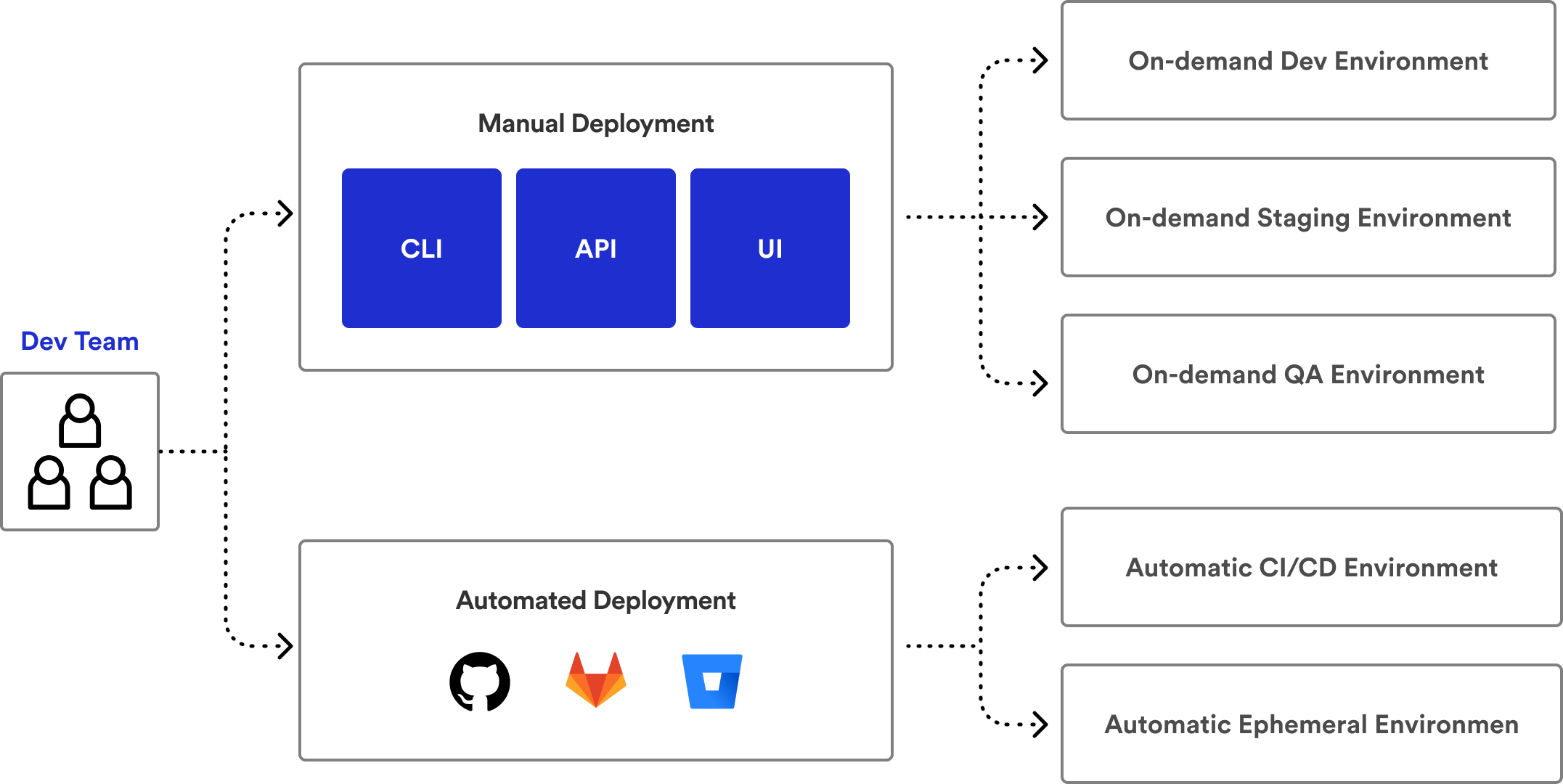For growing companies, speed and agility are essential to staying competitive in today’s fast-paced market. One of the most critical factors in accelerating product development is creating faster feedback loops. The quicker your team can test, identify issues, and refine code, the faster you can ship high-quality features. One of the best tools to achieve this goal is ephemeral environments.
Ephemeral environments are temporary, on-demand environments that replicate production settings, allowing teams to test changes quickly and efficiently. In this blog post, we’ll explore how ephemeral environments can help growing companies achieve faster feedback loops, boost productivity, and enhance product quality.
1. The Importance of Fast Feedback Loops in Software Development
In software development, feedback loops refer to the cycle of writing code, testing it, receiving feedback, and making improvements. The faster this loop, the quicker your team can iterate, fix bugs, and implement new features. However, for growing companies, traditional environment management often becomes a bottleneck. Here’s why fast feedback loops are essential:
- Early Issue Detection: The sooner bugs are identified, the less costly and time-consuming they are to fix.
- Improved Code Quality: Continuous feedback helps developers refine their code and reduce errors before release.
- Faster Delivery: Shorter feedback cycles mean faster releases, which is crucial for staying ahead in competitive markets.
For growing teams, automating the feedback process with ephemeral environments is an efficient way to overcome common bottlenecks.
2. What Are Ephemeral Environments?
Ephemeral environments are temporary, full-stack replicas of your production environment that are automatically created for testing new features. These environments are spun up on demand, typically for each pull request or branch, and are torn down after use. Unlike traditional environments, ephemeral environments are not persistent, meaning they exist only when needed, saving both time and resources.
Key features of ephemeral environments include:
- Consistency with Production: Every environment is an exact replica of production, ensuring accurate testing.
- Automatic Creation and Takedown: Environments are automatically created and removed when no longer needed, optimizing resource usage.
- Isolation: Each environment is isolated, so developers can test without affecting the rest of the team or the main codebase.

3. How Ephemeral Environments Accelerate Feedback Loops
a. Immediate Testing for Every Change
With ephemeral environments, every pull request automatically generates its own testing environment. This allows developers to instantly test new features, bug fixes, or experiments without waiting for shared environments to become available. This instant feedback helps identify issues much earlier in the development process.
b. Consistent, Realistic Testing
Because ephemeral environments are replicas of production, developers can test in real-world conditions. This eliminates the common issue of bugs slipping through the cracks due to differences between local and production environments. The consistency of these environments ensures that tests are accurate and reliable, leading to faster identification of issues.
c. Enhanced Collaboration
Teams can share ephemeral environments with QA, product managers, or other stakeholders for review. Instead of waiting for a central staging environment or demo to become available, everyone can see and interact with the changes in a live, isolated environment. This leads to faster feedback from all team members, improving collaboration and speeding up the overall process.
d. No More Waiting for Shared Environments
In growing teams, shared staging or testing environments can create bottlenecks, with multiple teams waiting for access. Ephemeral environments remove this roadblock by providing on-demand, isolated environments for each task. Developers no longer need to wait for a free environment, reducing downtime and speeding up feedback cycles.
See Ephemeral Environments in Action: Book a Demo Today
Ready to implement ephemeral environments and streamline your feedback loops? Let us show you how Bunnyshell can help you boost development speed and efficiency.
4. The Benefits of Ephemeral Environments for Growing Companies
For scaling teams, ephemeral environments offer numerous advantages:
- Faster Development Cycles: By enabling instant testing and faster feedback, ephemeral environments shorten the time between writing code and shipping features.
- Cost Efficiency: Since ephemeral environments are spun up and torn down automatically, they only use resources when needed, reducing cloud infrastructure costs.
- Reduced Complexity: As your team grows, managing multiple environments becomes increasingly complex. Ephemeral environments simplify this by automating the process, reducing the administrative overhead for your DevOps teams.
- Improved Product Quality: With faster, more consistent feedback, teams can quickly identify and resolve issues, leading to higher-quality code and fewer bugs in production.
Automating preview environments has saved us significant time and resources, speeding up our entire development process.
5. How to Implement Ephemeral Environments in Your Workflow
For growing companies looking to implement ephemeral environments, platforms like Bunnyshell make it easy to automate and manage these environments. Here’s how to get started:
Step 1: Integrate with Your CI/CD Pipeline
Ephemeral environments are most effective when integrated into your CI/CD pipeline. Tools like Bunnyshell can automatically generate environments for each pull request, ensuring that testing is done continuously throughout the development process.
Step 2: Define Environment Templates
Define templates for your ephemeral environments to ensure consistency across all development and testing environments. These templates should mirror your production setup as closely as possible to catch any issues that might arise during deployment.
Step 3: Automate Environment Creation and Takedown
Once your templates are ready, automate the creation and teardown of environments. This reduces the manual overhead of provisioning and managing environments, allowing your team to focus on writing and testing code.
Step 4: Monitor and Optimize
Track how frequently environments are spun up and how long they are used. Monitor costs to ensure that ephemeral environments are providing the desired efficiency. Platforms like Bunnyshell offer monitoring tools to help you optimize your usage over time.
6. Conclusion: The Future of Faster Feedback for Growing Teams
For growing companies, achieving faster feedback loops is crucial to maintaining a competitive edge and delivering high-quality products. Ephemeral environments provide a scalable, efficient solution for streamlining the feedback process, reducing bottlenecks, and improving collaboration across teams. By implementing these on-demand environments, your team can iterate more quickly, deliver features faster, and ensure better product quality—all while keeping infrastructure costs under control.
If your company is ready to accelerate product development, consider adopting ephemeral environments with a tool like Bunnyshell. It’s not just about speeding up feedback; it’s about building a faster, more efficient development process that scales with your business.
